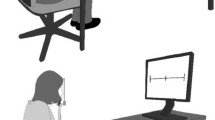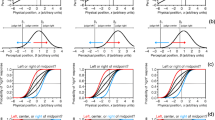Abstract
Neurologically normal subjects systematically misbisect space during visual line-bisection or similar tasks, generally erring to the left of the veridical center when bisecting horizontal lines, a phenomenon referred to as pseudoneglect. This phenomenon is usually interpreted as enhanced attention toward the left hemispace resulting in an overestimation of the leftward extent of a line. While most studies have examined the role of attention in spatial bias using spatial cueing methods in bisection tasks, Manly et al. (Neuropsychologia 43(12):1721–1728, 2005) proposed an original paradigm in which the participants’ alertness was diminished by sleep deprivation or prolonged execution of a line-bisection task. The authors reported a significant rightward shift in attention related to declining alertness, but they did not control eye movements and, consequently, modifications of scanning and fixation strategies with fatigue cannot be ruled out in their study. Here we examine whether a diminution in alertness induced by a 60-min-long Landmark task would diminish (or even reverse) this attentional bias, when eye movements are absent. Participants performed a forced-choice judgment about the location of a transaction mark in relation to the veridical center of a horizontal line. The results confirmed a significant decrease in the leftward bias over the course of the session but, in contrast to the findings of Manly et al. (2005), we did not observe a reverse bias from the left to the right hemispace. The results are discussed within the context of the hemisphere-activation model.


Similar content being viewed by others
References
Akerstedt T, Gillberg M (1990) Subjective and objective sleepiness in the active individual. Int J Neurosci 52(1–2):29–37
Arguin M, Bub DN (1993) Evidence for an independent stimulus-centered spatial reference frame from a case of visual hemineglect. Cortex 29(2):349–357
Billingsley RL, Simos PG, Sarkari S, Fletcher JM, Papanicolaou AC (2004) Spatio-temporal brain activation profiles associated with line bisection judgments and double simultaneous visual stimulation. Behav Brain Res 152(1):97–107
Binder J, Marshall R, Lazar R, Benjamin J, Mohr JP (1992) Distinct syndromes of hemineglect. Arch Neurol 49(11):1187–1194
Bisiach E, Capitani E, Porta E (1985) Two basic properties of space representation in the brain: evidence from unilateral neglect. J Neurol Neurosurg Psychiatry 48(2):141–144
Boller F, Howes D, Patten DH (1970) A behavioral evaluation of brain-scan estimates of lesion size. Neurology 20(9):852–859
Bowers D, Heilman KM (1980) Pseudoneglect: effects of hemispace on a tactile line bisection task. Neuropsychologia 18(4–5):491–498
Bradshaw JL, Bradshaw JA, Nathan G, Nettleton NC, Wilson LE (1986) Leftwards error in bisecting the gap between two points: stimulus quality and hand effects. Neuropsychologia 24(6):849–855
Bradshaw JL, Nathan G, Nettleton NC, Wilson L, Pierson J (1987) Why is there a left side underestimation in rod bisection? Neuropsychologia 25(4):735–738
Brodie EE, Pettigrew LE (1996) Is left always right? Directional deviations in visual line bisection as a function of hand and initial scanning direction. Neuropsychologia 34(5):467–470
Cabungcal JH, Misslisch H, Scherberger H, Hepp K, Hess BJ (2001) Effect of light sleep on three-dimensional eye position in static roll and pitch. Vis Res 41(4):495–505
Chokron S, Bartolomeo P, Perenin MT, Helft G, Imbert M (1998) Scanning direction and line bisection: a study of normal subjects and unilateral neglect patients with opposite reading habits. Cogn Brain Res 7(2):173–178
Corbetta M, Akbudak E, Conturo TE, Snyder AZ, Ollinger JM, Drury HA et al (1998) A common network of functional areas for attention and eye movements. Neuron 21(4):761–773
Dellatolas G, Vanluchene J, Coutin T (1996) Visual and motor components in simple line bisection: an investigation in normal adults. Cogn Brain Res 4(1):49–56
Fink GR, Marshall JC, Shah NJ, Weiss PH, Halligan PW, Grosse-Ruyken M et al (2000) Line bisection judgments implicate right parietal cortex and cerebellum as assessed by fMRI. Neurology 54(6):1324–1331
Fink GR, Marshall JC, Weiss PH, Zilles K (2001) The neural basis of vertical and horizontal line bisection judgments: an fMRI study of normal volunteers. Neuroimage 14(1Pt2):S59–S67
Fink GR, Marshall JC, Weiss PH, Toni I, Zilles K (2002) Task instructions influence the cognitive strategies involved in line bisection judgements: evidence from modulated neural mechanisms revealed by fMRI. Neuropsychologia 40(2):119–130
Finney DJ (1962) Probit analysis. Cambridge University Press, Cambridge
Foxe JJ, McCourt ME, Javitt DC (2003) Right hemisphere control of visuospatial attention: line-bisection judgments evaluated with high-density electrical mapping and source analysis. Neuroimage 19(3):710–726
Harvey M, Milner AD, Roberts RC (1995) An investigation of hemispatial neglect using the Landmark Task. Brain Cogn 27(1):59–78
Heilman KM, Van Den Abell T (1980) Right hemisphere dominance for attention: the mechanism underlying hemispheric asymmetries of inattention (neglect). Neurology 30(3):327–330
Ishiai S, Furukawa T, Tsukagoshi H (1989) Visuospatial processes of line bisection and the mechanisms underlying unilateral spatial neglect. Brain 112(Pt 6):1485–1502
Kerkhoff G (2001) Spatial hemineglect in humans. Prog Neurobiol 63(1):1–27
Kinsbourne M (1970) The cerebral basis of lateral asymmetries in attention. Acta Psychol 33:193–201
Lavine RA, Sibert JL, Gokturk M, Dickens B (2002) Eye-tracking measures and human performance in a vigilance task. Aviat Space Environ Med 73(4):367–372
Lewin JS, Friedman L, Wu D, Miller DA, Thompson LA, Klein SK et al (1996) Cortical localization of human sustained attention: detection with functional MR using a visual vigilance paradigm. J Comput Assist Tomogr 20(5):695–701
Manly T, Dobler VB, Dodds CM, George MA (2005) Rightward shift in spatial awareness with declining alertness. Neuropsychologia 43(12):1721–1728
Marshall RS, Lazar RM, Van Heertum RL, Esser PD, Perera GM, Mohr JP (1997) Changes in regional cerebral blood flow related to line bisection discrimination and visual attention using HMPAO-SPECT. Neuroimage 6(2):139–144
McCourt ME (2001) Performance consistency of normal observers in forced-choice tachistoscopic visual line bisection. Neuropsychologia 39(10):1065–1076
McCourt ME, Freeman P, Tahmahkera-Stevens C, Chaussee M (2001) The influence of unimanual response on pseudoneglect magnitude. Brain Cogn 45(1):52–63
McCourt ME, Garlinghouse M, Reuter-Lorenz PA (2005) Unilateral visual cueing and asymmetric line geometry share a common attentional origin in the modulation of pseudoneglect. Cortex 41(4):499–511
Mennemeier M, Vezey E, Chatterjee A, Rapcsak SZ, Heilman KM (1997) Contributions of the left and right cerebral hemispheres to line bisection. Neuropsychologia 35(5):703–715
Mesulam MM (1981) A cortical network for directed attention and unilateral neglect. Ann Neurol 10(4):309–325
Milner AD, Brechmann M, Pagliarini L (1992) To halve and to halve not: an analysis of line bisection judgements in normal subjects. Neuropsychologia 30(6):515–526
Moller C, Odkvist L, White V, Cyr D (1990) The plasticity of compensatory eye movements in rotatory tests. I. The effect of alertness and eye closure. Acta Oto-Laryngol 109(1–2):15–24
Nobre AC, Gitelman DR, Dias EC, Mesulam MM (2000) Covert visual spatial orienting and saccades: overlapping neural systems. Neuroimage 11(3):210–216
Oldfield RC (1971) The assessment and analysis of handedness: the Edinburgh inventory. Neuropsychologia 9(1):97–113
Pardo JV, Fox PT, Raichle ME (1991) Localization of a human system for sustained attention by positron emission tomography. Nature 349(6304):61–64
Posner MI, Driver J (1992) The neurobiology of selective attention. Curr Opin Neurobiol 2(2):165–169
Reuter-Lorenz PA, Kinsbourne M, Moscovitch M (1990) Hemispheric control of spatial attention. Brain Cogn 12(2):240–266
Robertson IH, North NT, Geggie C (1992) Spatiomotor cueing in unilateral left neglect: three case studies of its therapeutic effects. J Neurol Neurosurg Psychiatry 55(9):799–805
Schiff BB, Truchon C (1993) Effect of unilateral contraction of hand muscles on perceiver biases in the perception of chimeric and neutral faces. Neuropsychologia 31(12):1351–1365
Suzuki Y, Straumann D, Henn V (2000) Effects of alertness on three-dimensional eye movements. Jpn J Ophthalmol 44(5):457–462
Vingiano W (1991) Pseudoneglect on a cancellation task. Int J Neurosci 58(1–2):63–67
Author information
Authors and Affiliations
Corresponding author
Rights and permissions
About this article
Cite this article
Dufour, A., Touzalin, P. & Candas, V. Time-on-task effect in pseudoneglect. Exp Brain Res 176, 532–537 (2007). https://doi.org/10.1007/s00221-006-0810-2
Received:
Accepted:
Published:
Issue Date:
DOI: https://doi.org/10.1007/s00221-006-0810-2




